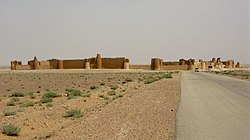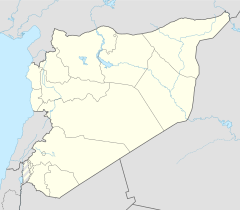Qasr al-Hayr al-Sharqi (Arabic: قصر الحير الشرقي, lit. 'Eastern al-Hayr Palace or the "Eastern Castle"') is a castle (qasr) in the middle of the Syrian Desert. It was built by the Umayyad caliph Hisham ibn Abd al-Malik in 728-29 CE in an area rich in desert fauna.[1] It was apparently used as a military and hunting outpost.[2] The palace is the counterpart of Qasr al-Hayr al-Gharbi, a nearby castle palace built one year earlier.[1] It is one of the so-called desert castles.
| Qasr al-Hayr al-Sharqi قصر الحير الشرقي | |
|---|---|
 Panoramic view of Qasr al-Hayr al-Sharqi | |
| General information | |
| Town or city | Homs Governorate |
| Country | Syria |
| Coordinates | 35°04′26″N 39°04′16″E / 35.073889°N 39.071111°E |
| Technical details | |
| Material | adobe |
Location
Qasr al-Hayr al-Sharq is 28 kilometres (17 mi) from Al-Sukhnah and 100 kilometres (62 mi) from Sergiopolis (Rusafa), near Bishri Mountain near Palmyran Middle Mountains.
Syrian Civil War
During Syria Civil War, Qasr al-Hayr al-Sharqi was captured by armed groups in 2013, then by ISIS. The Castle has been damaged by looting and vandalism. The visitor house has been burgled.[3] The Syrian Army recaptured the castle on 22 August 2017.[4]
Architecture
Like other Umayyad architectural works, the construction style was influenced by Byzantine and Sasanian architectures.[5]
The palace consists of a large open courtyard surrounded by thick bulwarks and towers guarding the entrances and each corner.[6] The ruins consist of three main components, known as the Small Enclosure, the Large Enclosure and the Outer Enclosure, each of which differ in form and function.[7] The palace(s) contains remnants of rooms, arches and columns which seem to be parts of a huge royal complex, including smaller structures, a reception hall, a mosque, a large bathhouse, gardens, courtyards and a complex water control system. Believed to each be made of a fine-grained limestone with an amber tint, these structures are each complex and visually stunning. In addition to the using stone, these towers exhibit a unique and charming decorative design, using brick and stucco.[8] The bigger palace has been several floors, with a huge gate and many towers. Towers were not built as defensive measures. There were also olive yards. The palaces were supplied with water by nearby Byzantine church by a canal 5,700 metres (6,200 yd) long.
Qasr al-Hayr al-Sharqi was ultimately abandoned at the start of the fourteenth century, resulting in an unprecedented opportunity to study urban life, order and planning during the early Islamic period.[8] The site was excavated in six seasons between 1964 and 1971 by renowned Islamic art historian Oleg Grabar.[9][10] Excavation of this site provided a unique example for historians and archaeologists of the ecological developments and decorative elements and materials of the area, such as ceramics and coins.[8] Some of the decorated parts have been moved to the National Museum of Damascus while the gate has been reconstructed in the Deir ez-Zor Museum.[11]
World Heritage Status
This site was added to the UNESCO World Heritage Tentative List on June 8, 1999, in the Cultural category.[12]
Gallery
- Walls and towers
- Walls and towers
- Byzantine arches and columns
See also





